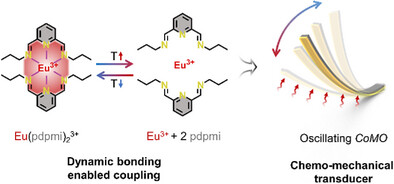
近日,中国科学院宁波材料技术与工程研究所陈涛团队报道了动态粘合环境驱动电机。这一研究成果于2025年11月5日发表在《德国应用化学》杂志上。
利用环境中的低密度能量并将其转化为宏观运动是生命系统的标志。然而,人工系统往往受到高能量需求和复杂控制机制的限制。
受沙门氏菌的启发,研究组提出了一种新的自振荡电机概念,利用分子水平的动态键来收集微小的环境能量,并为宏观的、自维持的行为提供动力。具体来说,他们开发了一种基于新型超分子PDMS材料的配位电机振荡器(CoMO),其热膨胀能力是普通PDMS的25倍,是被动层的近2000倍。CoMO可以收集低至体温的环境能量,可逆地解离配位交联,将分子转变为持续的宏观振荡。它的普适性通过CoMO的集体行为促进了宏观运动的放大。
此外,这一原理为环境驱动协调机器人(CoMbot)的发展提供了动力,使其具有多模式运动和适应不同地形的能力。这种动态化学转变使自维护系统的化学-机械耦合成为可能,为具有前所未有能力的机器人过渡-机械换能器材料系统和软机械铺平了新的道路。
附:英文原文
Title: Dynamic Bonding Enabled Ambient-Driven Motors
Author: Muqing Si, Zixiao Liu, Chi Chen, Wei Lu, Depeng Liu, Pengju Shi, Yi Yu, Yichen Yan, Ximin He, Tao Chen
Issue&Volume: 2025-11-05
Abstract: Harnessing ambient low-density energy and converting it into macroscopic motion is a hallmark of living systems. However, artificial systems are often limited by high energy requirements and intricate control mechanisms. Inspired by Salmonella, which uses dynamic ion-binding coordination for continuous motion, we proposed a novel concept of self-oscillating motors leveraging molecular-level dynamic bonding to harvest trivial ambient energy and power macroscopic, self-sustained behavior. Specifically, we developed a coordination motorized oscillator (CoMO) based on novel supramolecular PDMS material with 25-fold thermo-inflation ability of normal PDMS and nearly 2000-fold that of the passive layer. CoMO can harvest ambient energy as low as body temperature to reversibly dissociate coordination crosslinks, transforming molecular transitions into sustained macroscopic oscillation. Its universality facilitates the amplification of macroscopic motion via the collective behaviors of CoMOs. Moreover, this principle empowers the development of ambient-driven coordination motored robots (CoMbot) with multi-modal locomotion and adaptability across diverse terrains. Such dynamic chemical transitions enabled chemo-mechanical coupling for self-sustained systems, paving new avenues for robust transition-mechanical transducing material systems and soft machineries with unprecedented capabilities.
DOI: 10.1002/anie.202518011
Source: https://onlinelibrary.wiley.com/doi/10.1002/anie.202518011
Angewandte Chemie:《德国应用化学》,创刊于1887年。隶属于德国化学会,最新IF:16.823
官方网址:https://onlinelibrary.wiley.com/journal/15213773
投稿链接:https://www.editorialmanager.com/anie/default.aspx
